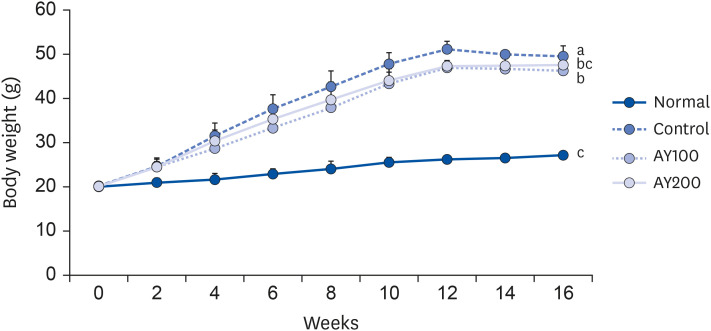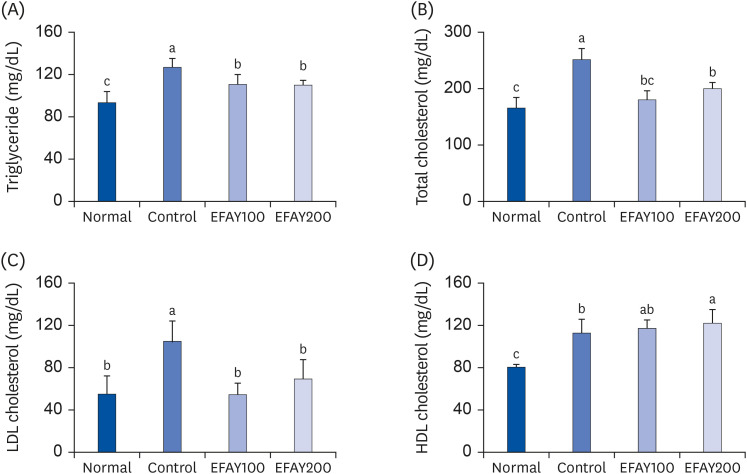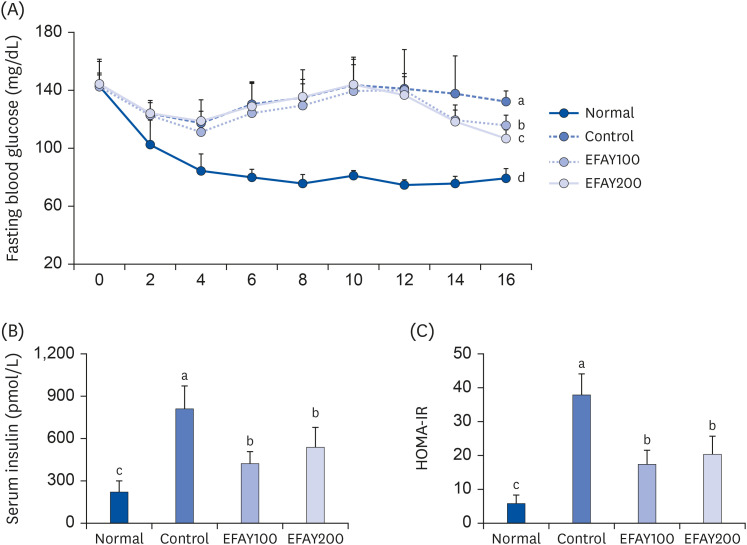Nutr Res Pract.
2022 Feb;16(1):46-59. 10.4162/nrp.2022.16.1.46.
The protective effects of Aster yomena (Kitam.) Honda on high-fat diet-induced obese C57BL/6J mice
- Affiliations
-
- 1Department of Food Science and Nutrition, Pusan National University, Busan 46241, Korea
- 2Department of Food Science, Gyeongsang National University, Jinju 52725, Korea
- 3Department of Plant Science and Technology, Chung-Ang University, Anseong 17546, Korea
- KMID: 2525512
- DOI: http://doi.org/10.4162/nrp.2022.16.1.46
Abstract
- BACKGROUND/OBJECTIVES
Aster yomena (Kitam.) Honda (AY) has remarkable bioactivities, such as antioxidant, anti-inflammation, and anti-cancer activities. On the other hand, the effects of AY against obesity-induced insulin resistance have not been reported. Therefore, this study examined the potential of AY against obesity-associated insulin resistance in highfat diet (HFD)-fed mice.
MATERIALS/METHODS
An obesity model was established by feeding C57BL/6J mice a 60% HFD for 16 weeks. The C57BL6/When ethyl acetate fraction from AY (EFAY) at doses of 100 and 200 mg/kg/day was administered orally to mice fed a HFD for the last 4 weeks. Normal and control groups were administered water orally. The body weight and fasting blood glucose were measured every week. Dietary intake was measured every other day. After dissection, blood and tissues were collected from the mice.
RESULTS
The administration of EFAY reduced body and organ weights significantly compared to HFD-fed control mice. The EFAY-administered groups also improved the serum lipid profile by decreasing the triglyceride, total cholesterol, and low-density lipoprotein compared to the control group. In addition, EFAY ameliorated the insulin resistance-related metabolic dysfunctions, including the fasting blood glucose and serum insulin level, compared to the HFD-fed control mice. The EFAY inhibited lipid synthesis and insulin resistance by down-regulation of hepatic fatty acid synthase and up-regulation of the AMPactivated protein kinase pathway. EFAY also reduced lipid peroxidation in the liver, indicating that EFAY protected hepatic injury induced by obesity.
CONCLUSIONS
These results suggest that EFAY improved obesity-associated insulin resistance by regulating the lipid and glucose metabolism, suggesting that AY could be used as a functional food to prevent obesity and insulin resistance.
Keyword
Figure
Reference
-
1. Blüher M. Adipose tissue dysfunction in obesity. Exp Clin Endocrinol Diabetes. 2009; 117:241–250. PMID: 19358089.
Article2. Wang S, Moustaid-Moussa N, Chen L, Mo H, Shastri A, Su R, Bapat P, Kwun I, Shen CL. Novel insights of dietary polyphenols and obesity. J Nutr Biochem. 2014; 25:1–18. PMID: 24314860.
Article3. Rosen ED, Spiegelman BM. Adipocytes as regulators of energy balance and glucose homeostasis. Nature. 2006; 444:847–853. PMID: 17167472.
Article4. Jung UJ, Choi MS. Obesity and its metabolic complications: the role of adipokines and the relationship between obesity, inflammation, insulin resistance, dyslipidemia and nonalcoholic fatty liver disease. Int J Mol Sci. 2014; 15:6184–6223. PMID: 24733068.
Article5. Klöting N, Blüher M. Adipocyte dysfunction, inflammation and metabolic syndrome. Rev Endocr Metab Disord. 2014; 15:277–287. PMID: 25344447.
Article7. Banack HR, Kaufman JS. The obesity paradox: understanding the effect of obesity on mortality among individuals with cardiovascular disease. Prev Med. 2014; 62:96–102. PMID: 24525165.
Article8. Blair SN, Brodney S. Effects of physical inactivity and obesity on morbidity and mortality: current evidence and research issues. Med Sci Sports Exerc. 1999; 31(Suppl):S646–S662. PMID: 10593541.
Article9. Kim AR, Jin Q, Jin HG, Ko HJ, Woo ER. Phenolic compounds with IL-6 inhibitory activity from Aster yomena . Arch Pharm Res. 2014; 37:845–851. PMID: 24014305.10. Seo SW. Protective effects of ethanol extract from Aster Yomena on acute pancreatitis. J Physiol Pathol Korean Med. 2019; 33:109–115.11. Jung BM, Lim SS, Park YJ, Bae SJ. Inhibitory effects on cell survival and quinone reductase induced activity of Aster yomena fractions on human cancer cells. J Korean Soc Food Sci Nutr. 2005; 34:8–12.12. Han MH, Jeong JS, Jeong JW, Choi SH, Kim SO, Hong SH, Park C, Kim BW, Choi YH. Ethanol extracts of Aster yomena (Kitam.) Honda inhibit adipogenesis through the activation of the AMPK signaling pathway in 3T3-L1 preadipocytes. Drug Discov Ther. 2017; 11:281–287. PMID: 29021504.13. Kim MJ, Kim JH, Lee S, Cho EJ, Kim HY. Determination of radical scavenging activity of Aster yomena (Kitam.) Honda. J Korea Acad Ind Coop Soc. 2018; 19:402–407.14. Kim MJ, Kim JH, Lee S, Kim HY, Cho EJ. Aster yomena (Kitam.) Honda inhibits adipocyte differentiation in 3T3-L1 cells. Int J Gerontol. 2019; 13:S33. 8.15. Fraulob JC, Ogg-Diamantino R, Fernandes-Santos C, Aguila MB, Mandarim-de-Lacerda CA. A mouse model of metabolic syndrome: Insulin resistance, fatty liver and non-alcoholic fatty pancreas disease (NAFPD) in C57BL/6 mice fed a high fat diet. J Clin Biochem Nutr. 2010; 46:212–223. PMID: 20490316.
Article16. Yang Q, Qi M, Tong R, Wang D, Ding L, Li Z, Huang C, Wang Z, Yang L. Plantago asiatica L. seed extract improves lipid accumulation and hyperglycemia in high-fat diet-induced obese mice. Int J Mol Sci. 2017; 18:1393.17. Choi KM, Lee YS, Kim W, Kim SJ, Shin KO, Yu JY, Lee MK, Lee YM, Hong JT, Yun YP, et al. Sulforaphane attenuates obesity by inhibiting adipogenesis and activating the AMPK pathway in obese mice. J Nutr Biochem. 2014; 25:201–207. PMID: 24445045.
Article18. Friedewald WT, Levy RI, Fredrickson DS. Estimation of the concentration of low-density lipoprotein cholesterol in plasma, without use of the preparative ultracentrifuge. Clin Chem. 1972; 18:499–502. PMID: 4337382.
Article19. Matthews DR, Hosker JP, Rudenski AS, Naylor BA, Treacher DF, Turner RC. Homeostasis model assessment: insulin resistance and β-cell function from fasting plasma glucose and insulin concentrations in man. Diabetologia. 1985; 28:412–419. PMID: 3899825.
Article20. Wallace TM, Levy JC, Matthews DR. Use and abuse of HOMA modeling. Diabetes Care. 2004; 27:1487–1495. PMID: 15161807.
Article21. Ohkawa H, Ohishi N, Yagi K. Assay for lipid peroxides in animal tissues by thiobarbituric acid reaction. Anal Biochem. 1979; 95:351–358. PMID: 36810.
Article22. Hill JO, Peters JC. Environmental contributions to the obesity epidemic. Science. 1998; 280:1371–1374. PMID: 9603719.
Article23. Hirsch J, Batchelor B. Adipose tissue cellularity in human obesity. Clin Endocrinol Metab. 1976; 5:299–311. PMID: 1085232.
Article24. Bays HE, Toth PP, Kris-Etherton PM, Abate N, Aronne LJ, Brown WV, Gonzalez-Campoy JM, Jones SR, Kumar R, La Forge R, et al. Obesity, adiposity, and dyslipidemia: a consensus statement from the National Lipid Association. J Clin Lipidol. 2013; 7:304–383. PMID: 23890517.
Article25. Fantuzzi G. Adipose tissue, adipokines, and inflammation. J Allergy Clin Immunol. 2005; 115:911–919. PMID: 15867843.
Article26. Shah A, Mehta N, Reilly MP. Adipose inflammation, insulin resistance, and cardiovascular disease. JPEN J Parenter Enteral Nutr. 2008; 32:638–644. PMID: 18974244.
Article27. Chandalia M, Abate N. Metabolic complications of obesity: inflated or inflamed? J Diabetes Complications. 2007; 21:128–136. PMID: 17331862.
Article28. Pickup JC, Crook MA. Is type II diabetes mellitus a disease of the innate immune system? Diabetologia. 1998; 41:1241–1248. PMID: 9794114.
Article29. Zeyda M, Stulnig TM. Obesity, inflammation, and insulin resistance--a mini-review. Gerontology. 2009; 55:379–386. PMID: 19365105.30. Kang HJ, Jeong JS, Park NJ, Go GB, Kim SO, Park C, Kim BW, Hong SH, Choi YH. An ethanol extract of Aster yomena (Kitam.) Honda inhibits lipopolysaccharide-induced inflammatory responses in murine RAW 264.7 macrophages. Biosci Trends. 2017; 11:85–94. PMID: 28179600.31. Lee HJ, Kim HS, Seo SW. Anti-obesity effect of Aster yomena ethanol extract in high fat diet-induced obese mice. J Physiol Pathol Korean Med. 2017; 31:348–355.32. Wieser V, Moschen AR, Tilg H. Inflammation, cytokines and insulin resistance: a clinical perspective. Arch Immunol Ther Exp (Warsz). 2013; 61:119–125. PMID: 23307037.
Article33. Arçari DP, Bartchewsky W Jr, dos Santos TW, Oliveira KA, DeOliveira CC, Gotardo ÉM, Pedrazzoli J Jr, Gambero A, Ferraz LF, Carvalho PO, et al. Anti-inflammatory effects of yerba maté extract (Ilex paraguariensis) ameliorate insulin resistance in mice with high fat diet-induced obesity. Mol Cell Endocrinol. 2011; 335:110–115. PMID: 21238540.34. Hariri N, Thibault L. High-fat diet-induced obesity in animal models. Nutr Res Rev. 2010; 23:270–299. PMID: 20977819.
Article35. Buettner R, Schölmerich J, Bollheimer LC. High-fat diets: modeling the metabolic disorders of human obesity in rodents. Obesity (Silver Spring). 2007; 15:798–808. PMID: 17426312.
Article36. Woods SC, Seeley RJ, Rushing PA, D’Alessio D, Tso P. A controlled high-fat diet induces an obese syndrome in rats. J Nutr. 2003; 133:1081–1087. PMID: 12672923.
Article37. Lin S, Thomas TC, Storlien LH, Huang XF. Development of high fat diet-induced obesity and leptin resistance in C57Bl/6J mice. Int J Obes Relat Metab Disord. 2000; 24:639–646. PMID: 10849588.
Article38. Gallou-Kabani C, Vigé A, Gross MS, Rabès JP, Boileau C, Larue-Achagiotis C, Tomé D, Jais JP, Junien C. C57BL/6J and A/J mice fed a high-fat diet delineate components of metabolic syndrome. Obesity (Silver Spring). 2007; 15:1996–2005. PMID: 17712117.
Article39. Messier C, Whately K, Liang J, Du L, Puissant D. The effects of a high-fat, high-fructose, and combination diet on learning, weight, and glucose regulation in C57BL/6 mice. Behav Brain Res. 2007; 178:139–145. PMID: 17222919.
Article40. Huang Y, He Y, Sun X, He Y, Li Y, Sun C. Maternal high folic acid supplement promotes glucose intolerance and insulin resistance in male mouse offspring fed a high-fat diet. Int J Mol Sci. 2014; 15:6298–6313. PMID: 24736781.41. Ikemoto S, Thompson KS, Takahashi M, Itakura H, Lane MD, Ezaki O. High fat diet-induced hyperglycemia: prevention by low level expression of a glucose transporter (GLUT4) minigene in transgenic mice. Proc Natl Acad Sci U S A. 1995; 92:3096–3099. PMID: 7724522.
Article42. Rivellese AA, De Natale C, Lilli S. Type of dietary fat and insulin resistance. Ann N Y Acad Sci. 2002; 967:329–335. PMID: 12079860.
Article43. Muniyappa R, Lee S, Chen H, Quon MJ. Current approaches for assessing insulin sensitivity and resistance in vivo: advantages, limitations, and appropriate usage. Am J Physiol Endocrinol Metab. 2008; 294:E15–E26. PMID: 17957034.
Article44. Sundaresan A, Harini R, Pugalendi KV. Ursolic acid and rosiglitazone combination alleviates metabolic syndrome in high fat diet fed C57BL/6J mice. Gen Physiol Biophys. 2012; 31:323–333. PMID: 23047945.45. Lelliott C, Vidal-Puig AJ. Lipotoxicity, an imbalance between lipogenesis de novo and fatty acid oxidation. Int J Obes Relat Metab Disord. 2004; 28(Suppl 4):S22–S28. PMID: 15592482.
Article46. Leonhardt M, Langhans W. Fatty acid oxidation and control of food intake. Physiol Behav. 2004; 83:645–651. PMID: 15621070.
Article47. Li JZ, Ye J, Xue B, Qi J, Zhang J, Zhou Z, Li Q, Wen Z, Li P. Cideb regulates diet-induced obesity, liver steatosis, and insulin sensitivity by controlling lipogenesis and fatty acid oxidation. Diabetes. 2007; 56:2523–2532. PMID: 17646209.
Article48. Hsu WH, Chen TH, Lee BH, Hsu YW, Pan TM. Monascin and ankaflavin act as natural AMPK activators with PPARα agonist activity to down-regulate nonalcoholic steatohepatitis in high-fat diet-fed C57BL/6 mice. Food Chem Toxicol. 2014; 64:94–103. PMID: 24275089.
Article49. Shaw RJ, Lamia KA, Vasquez D, Koo SH, Bardeesy N, Depinho RA, Montminy M, Cantley LC. The kinase LKB1 mediates glucose homeostasis in liver and therapeutic effects of metformin. Science. 2005; 310:1642–1646. PMID: 16308421.
Article50. Marín-Aguilar F, Pavillard LE, Giampieri F, Bullón P, Cordero MD. Adenosine monophosphate (AMP)-activated protein kinase: a new target for nutraceutical compounds. Int J Mol Sci. 2017; 18:288.
Article51. Lee HA, Cho JH, Afinanisa Q, An GH, Han JG, Kang HJ, Choi SH, Seong HA. Ganoderma lucidum extract reduces insulin resistance by enhancing AMPK activation in high-fat diet-induced obese mice. Nutrients. 2020; 12:3338.52. Zhao L, Zou T, Gomez NA, Wang B, Zhu MJ, Du M. Raspberry alleviates obesity-induced inflammation and insulin resistance in skeletal muscle through activation of AMP-activated protein kinase (AMPK) α1. Nutr Diabetes. 2018; 8:39. PMID: 29961765.
Article53. Das N, Sikder K, Ghosh S, Fromenty B, Dey S. Moringa oleifera Lam. leaf extract prevents early liver injury and restores antioxidant status in mice fed with high-fat diet. Indian J Exp Biol. 2012; 50:404–412. PMID: 22734251.54. Ha SK, Chae C. Inducible nitric oxide distribution in the fatty liver of a mouse with high fat diet-induced obesity. Exp Anim. 2010; 59:595–604. PMID: 21030787.
Article55. Shyamala MP, Venukumar MR, Latha MS. Antioxidant potential of the Syzygium aromaticum (Gaertn.) Linn. (cloves) in rats fed with high fat diet. Indian J Pharmacol. 2003; 35:99–103.56. Noeman SA, Hamooda HE, Baalash AA. Biochemical study of oxidative stress markers in the liver, kidney and heart of high fat diet induced obesity in rats. Diabetol Metab Syndr. 2011; 3:17. PMID: 21812977.
Article57. Sim JH, Lee HS, Lee S, Park DE, Oh K, Hwang KA, Kang HR, Ye SK, Kim HR. Anti-asthmatic activities of an ethanol extract of Aster yomena in an ovalbumin-induced murine asthma model. J Med Food. 2014; 17:606–611. PMID: 24738663.58. Amirkhizi F, Siassi F, Minaie S, Djalali M, Rahimi A, Chamari M. Is obesity associated with increased plasma lipid peroxidation and oxidative stress in women. ARYA Atheroscler. 2007; 2:189–192.59. Kim Y, Lee J. Esculetin, a coumarin derivative, suppresses adipogenesis through modulation of the AMPK pathway in 3T3-L1 adipocytes. J Funct Foods. 2015; 12:509–515.
Article60. Liao CC, Ou TT, Wu CH, Wang CJ. Prevention of diet-induced hyperlipidemia and obesity by caffeic acid in C57BL/6 mice through regulation of hepatic lipogenesis gene expression. J Agric Food Chem. 2013; 61:11082–11088. PMID: 24156384.
Article61. Jung UJ, Cho YY, Choi MS. Apigenin ameliorates dyslipidemia, hepatic steatosis and insulin resistance by modulating metabolic and transcriptional profiles in the liver of high-fat diet-induced obese mice. Nutrients. 2016; 8:305.
Article
- Full Text Links
- Actions
-
Cited
- CITED
-
- Close
- Share
- Similar articles
-
- Effects of fermented blueberry liquid in high-fat diet-induced obese C57BL/6J mice
- The protective effects of steamed ginger on adipogenesis in 3T3-L1 cells and adiposity in diet-induced obese mice
- Effects of high-fat diet induced obesity on tissue zinc concentrations and zinc transporter expressions in mice
- Impact of High Fat Diet-induced Obesity on the Plasma Levels of Monoamine Neurotransmitters in C57BL/6 Mice
- Expression of eotaxin in 3T3-L1 adipocytes and the effects of weight loss in high-fat diet induced obese mice






